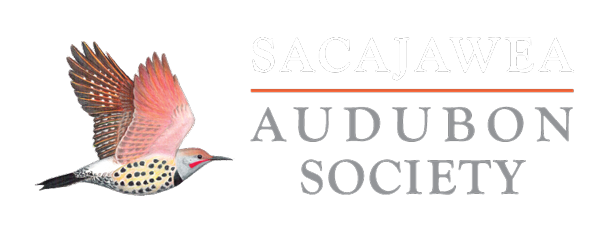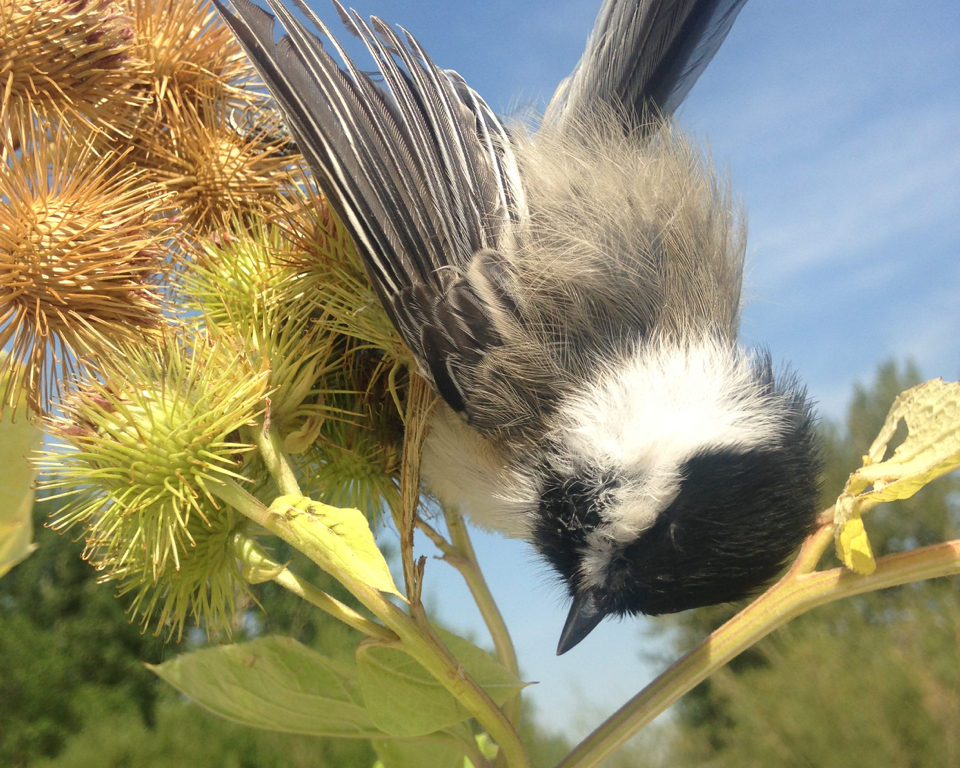Burdock is a particularly nasty invasive weed that is spreading along many of our local favorite trails, parks, and neighborhoods as well as across Montana ranchlands. Because the plant represents a danger to birds, other wildlife, and important bird habitats, Sacajawea Audubon conducts a yearly campaign to eradicate burdock using volunteer efforts. CLICK HERE for a handy information flyer you can download and print.
The Burdock Problem: Burdock can reach over 6 foot tall, with stalks of spiky purple flowers that become Velcro-like seed heads, often known as ‘cockleburs’. As the spiky flowers mature they become an increasing danger to song birds whose feathers can get entangled in them, causing the birds to die a slow death. Bats have also been found hanging dead in burdock, caught and unable to escape. You may know burdock from brushing against it and getting the burs caught in your hair, your clothes, or your dog’s fur. The burs get so entwined in fur that they are a terrible nuisance and even a danger to horses, cattle, sheep, deer, and many other species of wildlife.
Burdock is especially found in high quality bird habitat such as riparian corridors where there are shady places with moist soils, but it can also occur in grasslands and disturbed areas. In patches where burdock has been well established for years, it can create such a solid canopy of leaves that it crowds out all other native plants destroying valuable wildlife habitat.


How to identify Burdock: Burdock is a biennial, meaning it takes two years to complete its lifecycle. The first year it produces a basil rosette of large heart shaped leaves (up to 12 inches across and 20 inches long). The second year in July or early August it sends up a stalk (2-8 feet tall) with branches of purple flowers on the tips of prickly balls of burs. The burs mature and dry as the season progresses and the plant dies, leaving the burs to be picked up and spread by wildlife, livestock, dogs, and people. Each burdock plant can produce 1,000 to 10,000 seeds within its burs.
Eradicating Burdock: Burdock only propagates by seed. Control of burdock can be achieved by clipping off all the burs each year in August and making sure they get disposed of in the garbage. Cut down the whole plant afterwards to make sure it doesn’t bloom again. Or whole plants can be lopped off at the base in August and disposed of in the garbage or hauled to the landfill. It’s imperative that the burs not be left lying on the ground, or placed in compost piles, where they can germinate into hundreds of new plants.
Because burdock is a short-lived biennial and dies in two to three years, after it flowers, it is possible to control without chemicals. If all seeds are removed from a patch each year, eventually burdock dies out. However, seeds remain viable in the ground for several years and it can be very time consuming to control large difficult patches. The plants can easily be killed in the months of May or June by spraying with either Roundup or Weed B Gon. This is a time when the plants are actively growing and respond most effectively to these herbicides. The spray should be applied at recommended rates carefully and judiciously only to the leaves of the burdock, since both products will kill other plants that they come in contact with.
Sacajawea Audubon encourages everyone to be on the lookout for burdock and work to eliminate this horrible weed from our environment. Each year we organize volunteer work parties in late July and August to remove and properly dispose of burdock. Look for dates on our website each summer and join us in our efforts to ‘Knock out Burdock’.


